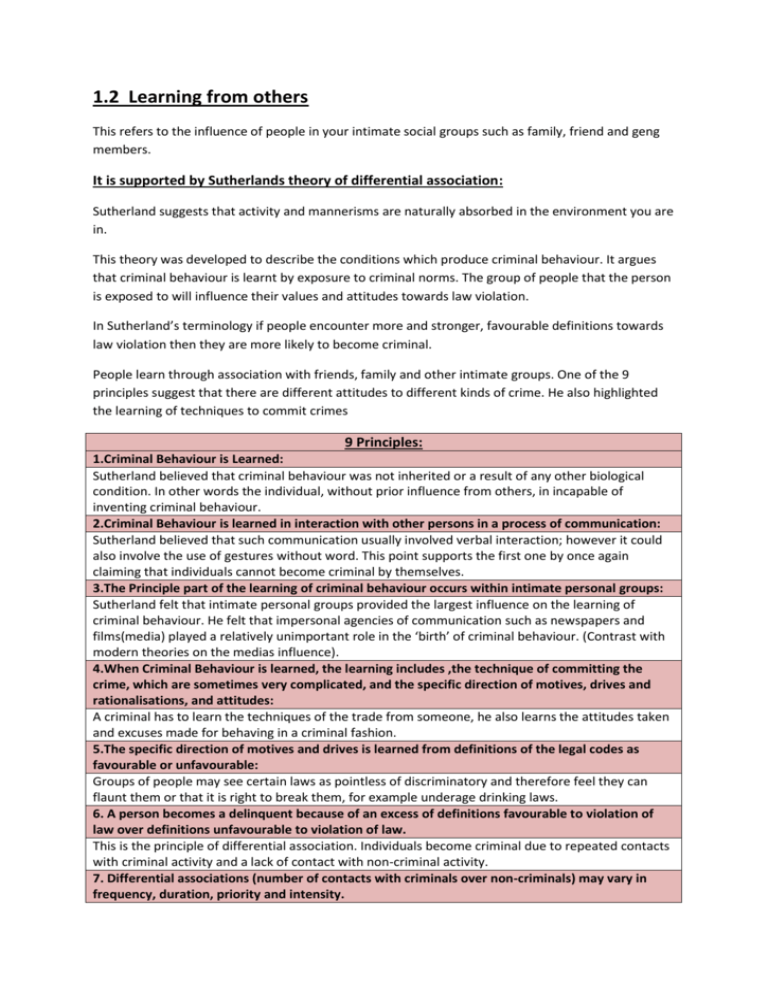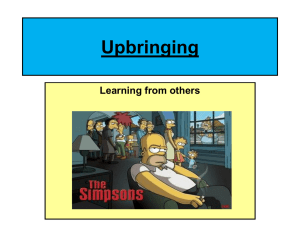1.2 learning from others
advertisement

1.2 Learning from others This refers to the influence of people in your intimate social groups such as family, friend and geng members. It is supported by Sutherlands theory of differential association: Sutherland suggests that activity and mannerisms are naturally absorbed in the environment you are in. This theory was developed to describe the conditions which produce criminal behaviour. It argues that criminal behaviour is learnt by exposure to criminal norms. The group of people that the person is exposed to will influence their values and attitudes towards law violation. In Sutherland’s terminology if people encounter more and stronger, favourable definitions towards law violation then they are more likely to become criminal. People learn through association with friends, family and other intimate groups. One of the 9 principles suggest that there are different attitudes to different kinds of crime. He also highlighted the learning of techniques to commit crimes 9 Principles: 1.Criminal Behaviour is Learned: Sutherland believed that criminal behaviour was not inherited or a result of any other biological condition. In other words the individual, without prior influence from others, in incapable of inventing criminal behaviour. 2.Criminal Behaviour is learned in interaction with other persons in a process of communication: Sutherland believed that such communication usually involved verbal interaction; however it could also involve the use of gestures without word. This point supports the first one by once again claiming that individuals cannot become criminal by themselves. 3.The Principle part of the learning of criminal behaviour occurs within intimate personal groups: Sutherland felt that intimate personal groups provided the largest influence on the learning of criminal behaviour. He felt that impersonal agencies of communication such as newspapers and films(media) played a relatively unimportant role in the ‘birth’ of criminal behaviour. (Contrast with modern theories on the medias influence). 4.When Criminal Behaviour is learned, the learning includes ,the technique of committing the crime, which are sometimes very complicated, and the specific direction of motives, drives and rationalisations, and attitudes: A criminal has to learn the techniques of the trade from someone, he also learns the attitudes taken and excuses made for behaving in a criminal fashion. 5.The specific direction of motives and drives is learned from definitions of the legal codes as favourable or unfavourable: Groups of people may see certain laws as pointless of discriminatory and therefore feel they can flaunt them or that it is right to break them, for example underage drinking laws. 6. A person becomes a delinquent because of an excess of definitions favourable to violation of law over definitions unfavourable to violation of law. This is the principle of differential association. Individuals become criminal due to repeated contacts with criminal activity and a lack of contact with non-criminal activity. 7. Differential associations (number of contacts with criminals over non-criminals) may vary in frequency, duration, priority and intensity. According to Sutherland, a precise description of a person’s criminal behaviour would be possible in quantitative form by analysing the number of contacts with criminals, which would lead to a mathematical ratio being reached. 8. The process of learning criminal behaviour by association with criminal and anti-criminal patterns involves all of the mechanisms that are involved in any other learning. In this point, Sutherland claims that criminal behaviour is learned just like every other behaviour. In other words he felt there was nothing ‘special’ or ‘abnormal’ about criminal behaviour, or criminals for that matter, thus going against the claims of biological and pathological theorists. 9. Whole criminal behaviour is an expression of general needs and values. It is not explained by those general needs and values since non-criminal behaviour is an expression of the same needs and values. A thief generally steals in order to obtain money. However such an action is no different from the work of an honest labourer, so this need in itself cannot explain theft. Theory is based on two core assumptions: Deviance occurs when people define a certain human situation as an appropriate occasion for violating social norms or criminal laws. Definitions of the situation are acquired through an individual’s history of post experience. Evaluation: Methodology: There is no reason to support his theory directly but it is simply a description of a thery in his textbook on criminology. Generaliseability: Difficult to generalise because is not based on research or evidence, even though it is common sense. Validity: Lacks validity because there is no evidence to support it. Nature/ Nurture: Supports the nurture side of the debate because it argues that criminality is caused by the influence of other people. Your interaction with intimate social groups and the number of favourable definitions for law violation.





